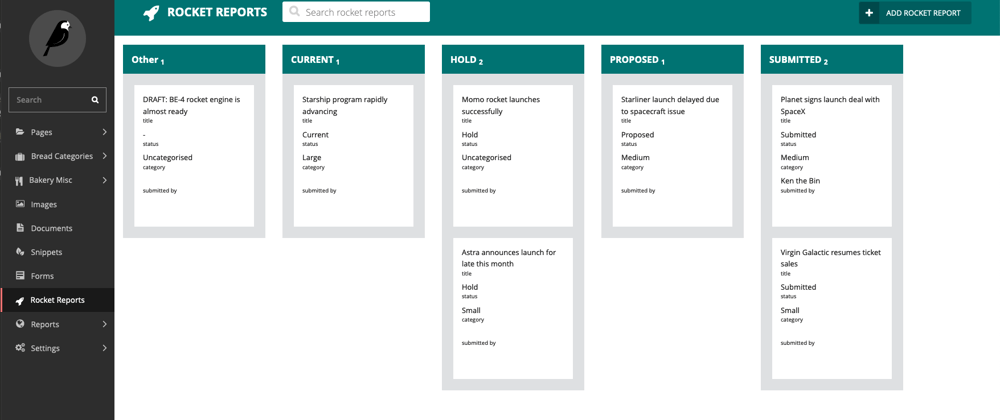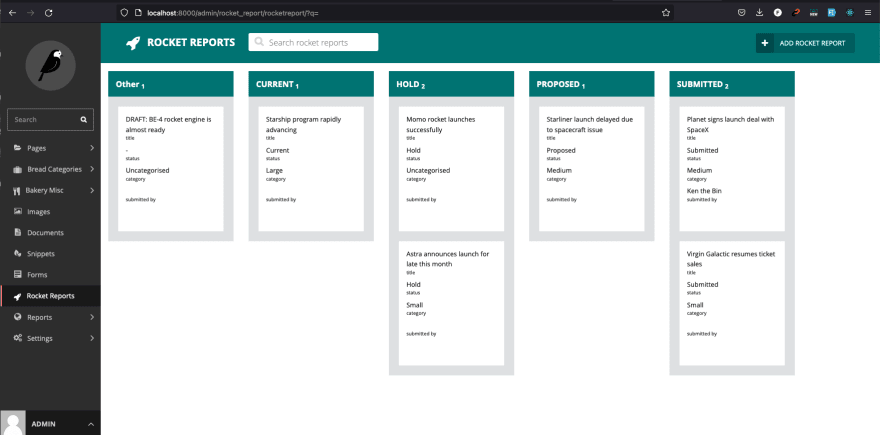Goal: Create a ModelAdmin mixin that will make it easy to show an index view as a Kanban board.
Why: Visual presentation is very helpful for planning and also a high-level understanding of information. Kanban boards provide a recognisable way to show sets of items in columns that represent their 'status' or grouping.
How: We want this to be as simple as possible, leveraging existing ModelAdmin conventions where possible and keeping as much of the logic being on the server. Drag & drop would be great but happy to sacrifice real-time / async Javascript behaviour to gain simplicity.
Inspiration: Kanban, notion.so, Trello, Github & Gitlab Kanban interface.
Getting Started
Versions
- Wagtail 2.14
- Python 3.6
- Django 3.2
- jkanban 1.3 (Javascript/npm library)
Key Parts to Understand
- Terminology
- ModelAdmin (Wagtail's not Django's)
- Class Mixin
Tutorial
1. Prepare a ModelAdmin model
For this tutorial we will be using ArsTechnica's Rocket Report as inspiration. As of writing the latest report was Rocket Report: Super Heavy lights up.
This regular post contains a title, byline, preamble, a reports section which breaks up the news snippets into class of launch (small, medium and large). At the end of the report there, is a small timeline of upcoming launches. The part we want to focus on for this tutorial is the reports section, and Wagtail's snippets are a perfect way to store this kind of related content in a centralised way.
Create app
We assume you already have a Wagtail application up and running, so our first step will be to find a place to store all our custom logic and models. We will start a new app called rocket_report.
- Run
django-admin startapp rocket_report - Update your
settings.py
INSTALLED_APPS = [
# ...
'rocket_report',
# ... wagtail & django items
# ensure that snippets and modeladmin apps are added
'wagtail.snippets',
'wagtail.contrib.modeladmin',
]
There will now be an app folder rocket_report with models, views, etc.
Create page Model
Our next step will be to define our RocketReportPage page model.
- Add a page model to your
models.pyfile, code example below. - Run
./manage.py makemigrations&./manage.py migrate - Restart the dev server to validate that we can now add a Rocket Report Page in Wagtail's admin
- Add one page for use throughout the rest of the tutorial
from django.db import models
from modelcluster.fields import ParentalKey
from wagtail.core.models import Page, Orderable
from wagtail.core.fields import RichTextField
from wagtail.admin.edit_handlers import FieldPanel, InlinePanel
from wagtail.images.edit_handlers import ImageChooserPanel
class RocketReportPage(Page):
# Database fields
byline = models.CharField(blank=True, max_length=120)
preamble = RichTextField(blank=True)
main_image = models.ForeignKey(
"wagtailimages.Image",
null=True,
blank=True,
on_delete=models.SET_NULL,
related_name="+",
)
# Editor panels configuration
content_panels = Page.content_panels + [
FieldPanel("byline"),
FieldPanel("preamble", classname="full"),
ImageChooserPanel("main_image"),
# TBC - reports
InlinePanel("related_launches", label="Timeline"),
]
class Launch(Orderable):
page = ParentalKey(
RocketReportPage, on_delete=models.CASCADE, related_name="related_launches"
)
date = models.DateField("Launch date")
details = models.CharField(max_length=255)
panels = [
FieldPanel("date"),
FieldPanel("details"),
]
Create snippet Model
Our rocket report items will be Wagtail Snippets, this gives a simple way to edit, manage and select these items for our pages.
- Add the snippet model to your same
models.pyfile, code example below. - Run
./manage.py makemigrations&./manage.py migrate. - Restart the dev server to validate that we can now add the snippet in Wagtail's admin.
- Add some snippet entries for use throughout the rest of the tutorial.
- Note - a reminder to ensure
INSTALLED_APPScontains'wagtail.snippets'
from django.db import models
# ... include existing imports from model.py
from wagtail.snippets.models import register_snippet
from wagtail.snippets.edit_handlers import SnippetChooserPanel
from wagtail.admin.edit_handlers import FieldPanel
class RocketReportPage(Page):
# ...
content_panels = Page.content_panels + [
# ... other field panels
ImageChooserPanel("main_image"),
# ... other field panels
]
@register_snippet
class RocketReport(models.Model):
STATUS_CHOICES = [
("SUBMITTED", "Submitted"),
("REVIEWED", "Reviewed"),
("PROPOSED", "Proposed"),
("HOLD", "Hold"),
("CURRENT", "Current"),
]
CATEGORY_CHOICES = [
("BLANK", "Uncategorised"),
("SMALL", "Small"),
("MEDIUM", "Medium"),
("LARGE", "Large"),
]
submitted_url = models.URLField(null=True, blank=True)
submitted_by = models.CharField(max_length=255, blank=True)
status = models.CharField(max_length=255, blank=True, choices=STATUS_CHOICES)
title = models.CharField(max_length=255)
content = RichTextField(blank=True)
category = models.CharField(
max_length=255, choices=CATEGORY_CHOICES, default="BLANK"
)
panels = [
FieldPanel("title"),
FieldPanel("status"),
FieldPanel("category"),
FieldPanel("content"),
FieldPanel("submitted_url"),
FieldPanel("submitted_by"),
]
def __str__(self):
return self.title
class RocketReportPageReportPlacement(Orderable, models.Model):
page = ParentalKey(
RocketReportPage, on_delete=models.CASCADE, related_name="rocket_reports"
)
rocket_report = models.ForeignKey(
RocketReport, on_delete=models.CASCADE, related_name="+"
)
panels = [
SnippetChooserPanel("rocket_report"),
]
def __str__(self):
return self.page.title + " -> " + self.rocket_report.title
Register with ModelAdmin
Now we can register the report model using ModelAdmin. Note that this is Wagtail's ModelAdmin not Django's.
- Add
wagtail.contrib.modeladminto yourINSTALLED_APPSin yoursettings.py - Add a new
ModelAdminclass in admin.py, code example below. - Register this class in a new file
wagtail_hooks.py, code example below. - Validate that we now have an admin sidebar item for 'Rocket Reports' which will show the default ModelAdmin item list.
# admin.py
from wagtail.contrib.modeladmin.options import ModelAdmin
from .models import RocketReport
class RocketReportAdmin(ModelAdmin):
model = RocketReport
menu_icon = "fa-rocket"
list_display = ("title", "status", "category", "submitted_by")
list_filter = ("status", "category")
search_fields = ("title", "status", "category", "submitted_by")
# wagtail_hooks.py
from wagtail.contrib.modeladmin.options import modeladmin_register
from .admin import RocketReportAdmin
modeladmin_register(RocketReportAdmin)
2. Create a template, view & mixin
We are going to now set up a custom KanbanMixin that will house the customisations to our ModelAdmin. We could put all of these customisations directly on our RocketReportAdmin but we want to set up something reusable. It would be good to have a basic understanding of how to customise the index view (listing) before reading on.
Create Kanban index template
We will be using a Javascript library to do the client-side rendering and handling of interaction for our basic Kanban board. There are a lot of Kanban JS libraries on Github and a few Kanban packages on NPM.
The package we will use is Jkanban, it has a simple API and does not rely on third-party dependencies. For simplicity, we will use the jsdelivr service to provide our script and CSS, find the package and use the dist directory to get your script and style tags.
- Create a template file
/templates/modeladmin/kanban_index.html - To inherit the existing modeladmin index listing layout (header, search bar, title etc) add
{% extends "modeladmin/index.html" %}at the top - The content blocks we will use, provided by the above template are
extra_css,extra_jsandcontent_main. - Remember to add
{{ block.super }}to the js & css blocks so that existing scripts and styles will be used. -
content_mainblock - add a div that will contain the Kanban with classkanban-wrapper listingand an inner div with an idkanban-mountwhich is used by JKanban to add the rendered kanban board -
extra_cssblock - Add thelinktag from jsdelivr and some basic styles within a<style>tag, in the code below we are starting with some margins and handling of longer boards -
extra_jsblock - our goal is to simply load up some dummy data based on the options docs for jKanban
document.addEventListener("DOMContentLoaded", function () {
var options = {
boards: [
{
id: "column-0",
title: "Column A",
item: [
{ id: "item-1", title: "Item 1" },
{ id: "item-2", title: "Item 2" },
{ id: "item-1", title: "Item 3" },
],
},
{
id: "column-1",
title: "Column B",
item: [
{ id: "item-4", title: "Item 4" },
{ id: "item-5", title: "Item 4" },
{ id: "item-5", title: "Item 6" },
],
},
],
};
// build the kanban board with supplied options
var kanban = new jKanban(
Object.assign({}, options, { element: "#kanban-mount" })
);
});
Full template code
{% extends "modeladmin/index.html" %}
{% comment %} templates/modeladmin/kanban_index.html {% endcomment %}
{% block extra_css %}
{{ block.super }}
<link rel="stylesheet" href="https://cdn.jsdelivr.net/npm/jkanban@1/dist/jkanban.min.css">
<style>
.kanban-wrapper {
width: 100%;
overflow-x: auto; /* add horizontal scrolling for wide boards */
margin-top: 1rem;
margin-bottom: 1rem;
}
.kanban-item {
min-height: 4rem;
}
</style>
{% endblock %}
{% block extra_js %}
{{ block.super }}
<script src="https://cdn.jsdelivr.net/npm/jkanban@1/dist/jkanban.js"></script>
<script>
document.addEventListener('DOMContentLoaded', function() {
var options = {
boards: [
{
id: 'column-0',
title: 'Column A',
item: [{ id: 'item-1', title: 'Item 1'}, { id: 'item-2', title: 'Item 2'}, { id: 'item-1', title: 'Item 3'}]}
,
{
id: 'column-1',
title: 'Column B',
item: [{ id: 'item-4', title: 'Item 4'}, { id: 'item-5', title: 'Item 4'}, { id: 'item-5', title: 'Item 6'}]
}
]
};
// build the kanban board with supplied options
// see: https://github.com/riktar/jkanban#var-kanban--new-jkanbanoptions
var kanban = new jKanban(Object.assign({}, options, {element: '#kanban-mount'}));
});
</script>
{% endblock %}
{% block content_main %}
<div class="kanban-wrapper listing">
<div id="kanban-mount"></div>
</div>
{% endblock %}
Create Mixin with template override
A template is only good if we can get our ModelAdmin to use it when rendering the index listing view instead of the default. We can leverage a mixin approach to override the ModelAdmin methods while still honouring the existing config on a per app or model basis.
- We will store our mixin in the
admin.pyfile. -
ModelAdminuses a methodget_index_templateto get the index listing template, simply override this to call the definedindex_template_nameorget_templates("kanban_index"). - This will ensure that the template made above will be found at
templates/modeladmin/kanban_index.html - Be sure to add the mixin to your
RocketReportAdminclass, before theModelAdminusage.
# rocket_report/admin.py
class KanbanMixin:
def get_index_template(self):
# leverage the get_template to allow individual override on a per model basis
return self.index_template_name or self.get_templates("kanban_index")
class RocketReportAdmin(KanbanMixin, ModelAdmin):
model = RocketReport
# ...
Create View to supply mock data to the kanban board
Our goal is to keep as much logic on the server, so we need a way to provide the board data from our Django view to our client. Doing this comes with some issues of encoding/decoding and ensuring that server generated content cannot inject Javascript.
Thankfully, Django helps us out with its builtin tag json_script which provides a way for sever generated content to be provided to JS in a view in a safe way.
- Add a new view to the app's
views.pycalledKanbanView - This view will inherit the modeladmin
wagtail.contrib.modeladmin.views.IndexView - Override
get_context_data, calling super and then addingkanban_optionswith similar dummy data that we used in the template - Use this
KanbanViewwithin theKanbanMixin - Update the
kanban_index.htmlto inject the JSON data via json-script
# views.py
from wagtail.contrib.modeladmin.views import IndexView
class KanbanView(IndexView):
def get_kanban_data(self, context):
return [
{
"id": "column-id-%s" % index,
"item": [
{"id": "item-id-%s" % obj["pk"], "title": obj["title"],}
for index, obj in enumerate(
[
{"pk": index + 1, "title": "%s Item 1" % column},
{"pk": index + 2, "title": "%s Item 2" % column},
{"pk": index + 3, "title": "%s Item 3" % column},
]
)
],
"title": column,
}
for index, column in enumerate(["column a", "column b", "column c"])
]
def get_context_data(self, **kwargs):
context = super().get_context_data(**kwargs)
# replace object_list in context as we do not want it to be paginated
context["object_list"] = self.queryset
# see: https://github.com/riktar/jkanban#var-kanban--new-jkanbanoptions
context["kanban_options"] = {
"addItemButton": False,
"boards": self.get_kanban_data(context),
"dragBoards": False,
"dragItems": False,
}
return context
# rocket_report/admin.py
from wagtail.contrib.modeladmin.options import ModelAdmin
from .views import KanbanView
from .models import RocketReport
class KanbanMixin:
index_view_class = KanbanView
def get_index_template(self):
#...
class RocketReportAdmin(KanbanMixin, ModelAdmin):
model = RocketReport
# ...
{% comment %} templates/modeladmin/kanban_index.html (just the JS block shown) {% endcomment %}
{% block extra_js %}
{{ block.super }}
<script src="https://cdn.jsdelivr.net/npm/jkanban@1/dist/jkanban.js"></script>
{{ kanban_options|json_script:"kanban-options" }}
<script>
document.addEventListener('DOMContentLoaded', function() {
// load the options from server
var options = JSON.parse(document.getElementById('kanban-options').textContent);
console.log('loaded', { options })
// build the kanban board with supplied options
// see: https://github.com/riktar/jkanban#var-kanban--new-jkanbanoptions
var kanban = new jKanban(Object.assign({}, options, {element: '#kanban-mount'}));
});
</script>
{% endblock %}
3. Render items columns from actual data
Our goal here is to finish this basic implementation by generating columns and items from the correct Model. To achieve this we will revise the KanbanMixin to have some methods for smaller templates (used for the title/content) and methods to determine what field will be used for the columns. After that, we can revise the View to prepare all the data.
Revise the KanbanMixin and add small templates
- Add a method
get_kanban_item_templateto look for a template with the namekanban_itembut also allow the Mixin usage to declare an attributekanban_item_template_name. This way we can have simple defaults but allow eachKanbanMixinto declare custom templates for the items on a per model basis. - Add a method
get_kanban_column_title_templatethat is similar to the above but for the column title. - Add a method
get_kanban_column_fieldwhich will return the first field name from thelist_filterattribute on the Mixin usage, this means we can leverage the existing ModelAdmin attributes approach. - Finally, add a method
get_kanban_column_name_defaultfor a default column name, this will be used when there is no value for the Kanban column field (e.g. a drop-down where a None/blank value is selected).
# rocket_report/admin.py
class KanbanMixin:
index_view_class = KanbanView
def get_index_template(self):
# leverage the get_template to allow individual override on a per model basis
return self.index_template_name or self.get_templates("kanban_index")
def get_kanban_item_template(self):
# leverage the get_template to allow individual override on a per model basis
return getattr(
self, "kanban_item_template_name", self.get_templates("kanban_item")
)
def get_kanban_column_title_template(self):
# leverage the get_template to allow individual override on a per model basis
return getattr(
self,
"kanban_column_title_template_name",
self.get_templates("kanban_column_title"),
)
def get_kanban_column_field(self):
# return a field to use to determine which column the item will be shown in
# pull in the first value from list_filter if no specific column set
list_filter = getattr(self, "list_filter", [])
field = list_filter[0] if list_filter else None
return field
def get_kanban_column_name_default(self):
# used for the column title name for None or no column scenarios
return getattr(self, "kanban_column_name_default", "Other")
# ...
Revise the KanbanMixin and add small templates
There is a lot changed in this final step, the main methods added to the KanbanView are to generate all the various parts (columns/items) and use the template in each of those parts set up in the KanbanMixin.
- Add a method
render_kanban_item_htmlwhich will pull in the action buttons (part ofModelAdmin), the template and then pass all the data to the template from theget_kanban_item_templatemethod. This will return a string (HTML) which will, in turn, be passed to the JSON data for the Kanban board. - Add a method
render_kanban_column_title_htmlwhich will pass the context to the configured title template. - Add a method
get_kanban_columnsthat uses a query which will gather ALL the Model instances and prepare the data which has groupings of those Models by their column, along with the columns (with their names) also. - Replace the method
get_kanban_datawith a series of List parsing that goes through the column data and prepares the items to be placed within each column in a format that, when converted to JSON, is suitable for jKanban.
from django.contrib.admin.templatetags.admin_list import result_headers
from django.template.loader import render_to_string
from django.db.models import CharField, Count, F, Value
from wagtail.contrib.modeladmin.templatetags.modeladmin_tags import result_list
from wagtail.contrib.modeladmin.views import IndexView
class KanbanView(IndexView):
def render_kanban_item_html(self, context, obj, **kwargs):
"""
Allow for template based rendering of the content that goes inside each item
Prepare action buttons that will be the same as the classic modeladmin index
"""
kwargs["obj"] = obj
kwargs["action_buttons"] = self.get_buttons_for_obj(obj)
context.update(**kwargs)
template = self.model_admin.get_kanban_item_template()
return render_to_string(template, context, request=self.request,)
def render_kanban_column_title_html(self, context, **kwargs):
"""
Allow for template based rendering of the content that goes at the top of a column
"""
context.update(**kwargs)
template = self.model_admin.get_kanban_column_title_template()
return render_to_string(template, context, request=self.request,)
def get_kanban_columns(self):
"""
Gather all column related data
columns: name & count queryset
default: label of a column that either has None value or does not exist on the field
field: field name that is used to get the value from the instance
key: internal use key to refer to the annotated column name label value
queryset original queryset annotated with the column name label
"""
object_list = self.queryset
column_field = self.model_admin.get_kanban_column_field()
column_name_default = self.model_admin.get_kanban_column_name_default()
column_key = "__column_name"
queryset = object_list.annotate(
__column_name=F(column_field)
if column_field
else Value(column_name_default, output_field=CharField())
)
order = F(column_key).asc(nulls_first=True) if column_field else column_key
columns = (
queryset.values(column_key).order_by(order).annotate(count=Count("pk"))
)
return {
"columns": columns,
"default": column_name_default,
"field": column_field,
"key": column_key,
"queryset": queryset,
}
def get_kanban_data(self, context):
"""
Prepares the data that is used by the Kanban js library
An array of columns, each with an id, title (html) and item
Item value in each column contains an array of items which has a column, id & title (html)
"""
columns = self.get_kanban_columns()
# use existing model_admin utility to build headers/values
result_data = result_list(context)
# set up items (for ALL columns)
items = [
{
"column": getattr(obj, columns["key"]),
"id": "item-id-%s" % obj.pk,
"title": self.render_kanban_item_html(
context,
obj,
fields=[
{"label": label, "value": result_data["results"][index][idx]}
for idx, label in enumerate(result_data["result_headers"])
],
),
}
for index, obj in enumerate(columns["queryset"])
]
# set up columns (aka boards) with sets of filtered items inside
return [
{
"id": "column-id-%s" % index,
"item": [
item for item in items if item["column"] == column[columns["key"]]
],
"title": self.render_kanban_column_title_html(
context,
count=column["count"],
name=column.get(columns["key"], columns["default"])
or columns["default"],
),
}
for index, column in enumerate(columns["columns"])
]
def get_context_data(self, **kwargs):
# ... (same as before)
Final Solution
- Code can be found Github / lb-
Future Improvements & Feedback
- It took a while to get this published, so hopefully it all came together well but I would love any feedback and hope this is helpful to someone.
- Better handling of pre-setting 'values' for each item's field/value, currently renders inside
<td>tags due to existingModelAdminassumptions. - Handling drag & drop (even real-time) with column number updates and toast style messages, you can view a rough version of this in the repo above (see commit ORIGINAL ROUGH IMPLEMENTATION).
Notes
- Updated 20/08/2021 - added notes about updating
INSTALLED_APPS








Oldest comments (0)